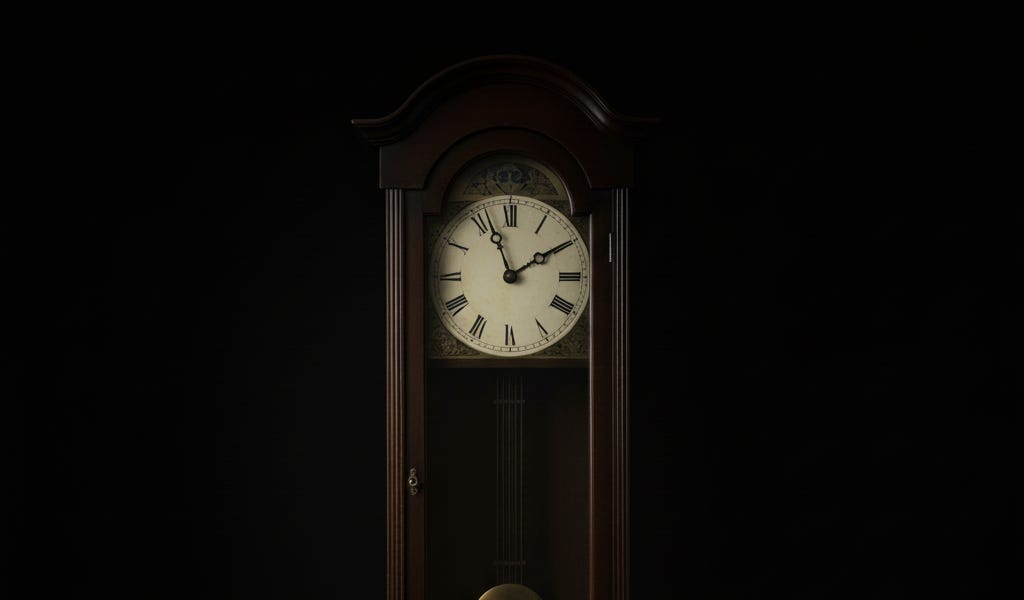
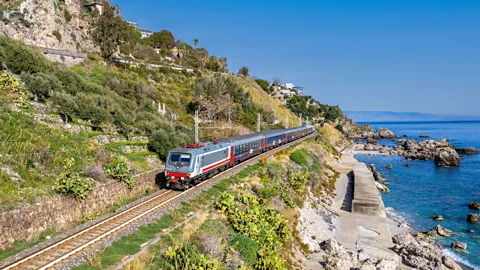 Alamy
Alamy
Italy's sleeper from Milan to Sicily ends with a rare rail-ferry crossing that's threatened by a new mega bridge.
Our ferry cuts through the roiling waters of the Strait of Messina under clouds that blanket all but the hems of Sicily's distant mountains. The sea passage to the Italian island doesn't want for drama. It's governed by tidal currents so strong they inspired Scylla and Charybdis, the sea monsters in Homer's Odyssey, and is overseen by a golden statue of the Madonna at the end of Messina Harbour, arm raised in blessing. But my eye is drawn to a stranger sight: the train carriages travelling across the sea on the ferry itself.
This is unique cargo. The narrow strait is the only place in Europe where passenger trains still travel by sea. Every morning, passengers aboard the Intercity Notte follow the same ritual: watching the train split in the southern Italian city of Villa San Giovanni, get shunted onto the ferry’s tracks and carried across to the city of Messina before being reassembled for the final run to Palermo or Syracuse.
"It is a small engineering choreography that keeps two shores and two worlds together every day: students, workers, families returning home, strait commuters, tourists who choose the slow pace of the night train," Francesca Serra, director of Intercity operations at national operator Trenitalia, tells me.
But this choreography connecting land and sea may soon come to an end.
In August, the Italian government revived long-standing plans to build a vast €13.5bn (£11.7bn) suspension bridge over the strait – one of the world's most ambitious engineering projects. Supporters see it as progress, while critics warn it could drain resources from southern Italy's more urgent infrastructure needs. Whether or not it's ever built, the proposal has cast a shadow over one of Europe's most poetic journeys and the sense of ritual and connection it represents.

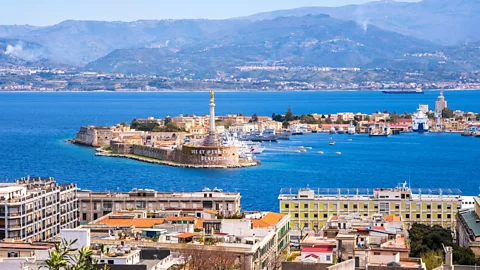 Getty Images
Getty Images
When I travelled on the Intercity Notte in February 2025, none of this seemed particularly urgent. The bridge plan was still languishing in political limbo and the sea crossing felt like an evocative journey that would surely always exist. This was the backbone of an overland trip my partner and I were taking from Nottingham to Sicily, and we wound our way down through France and Turin before arriving at the grand Milano Centrale. From here, the overnight journey to Syracuse in Sicily – Italy's longest sleeper service – promised something special: a 1,489km passage through the length of Italy, linking mainland and island.
It is a small engineering choreography that keeps two shores and two worlds together every day – Francesca Serra
Our train left at 19:40 and night was closing in as we rattled down the coast, passing bright constellations of Cinque Terre towns. Compartment doors left open offered glimpses of life along the aisle: families playing cards, an old man with a cup of wine, a couple and their handsome Italian greyhound. I drifted asleep, stirred occasionally by melodic Tannoy announcements from dark platforms washed in orange light.
Around 07:00, I was woken by a knock at the door and, scrambling for my glasses, found the carriage attendant waiting patiently with a shot of espresso. A breakfast tray of juice, croissant, dry biscuits and apricot spread followed. Calabrian towns began their days beneath pale skies, which took on a moodier complexion over the Tyrrhenian Sea, flecked with lightning. We came into the salt-licked station of Villa San Giovanni just in time to see Intercity day train returning from Sicily snake out of the ferry's open bow, pulled by a sturdy locomotive.
Our train continued a little way along the track before we switched direction and were pushed into the empty vessel. I felt a jolt as our row of carriages was decoupled from the one in front and my sea views were briefly replaced by metal walls. As we were pushed into the bowels of the ferry, a well-rehearsed crew in high-vis jackets shouted instructions at each other above the burr of machinery.

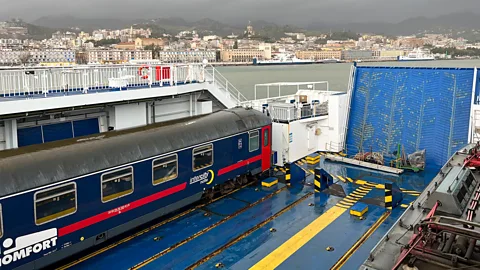 Lottie Limb
Lottie Limb
Train-ferries emerged in the late 19th Century as an enterprising answer to the question of what happens when an expanding rail network meets a large body of water. The Strait of Messina service began in 1899 and was once one of several places in Europe where passenger trains were loaded onto ferries, including between Dover and Dunkirk. After the 2019 closure of the Puttgarden-Rødby service between Germany and Denmark and the seasonal Sassnitz-Trelleborg route linking Germany and Sweden in 2020, the Intercity is now the last one running. All the rest were replaced by bridges or tunnels, or proved too expensive to maintain as demand fell in favour of air travel.
More like this:
• Europe's stunning high-tech luxury train
• Why is Europe rail travel so complex and expensive?
• A new night train connecting some of the continent's great cities
However, night trains are now enjoying a renaissance as travellers seek slower and more sustainable alternatives to flying. According to Serra, more than 60% of passengers use the Intercity Notte trains for leisure travel, making it the "holiday train". The second-most-common reason, she says, is returning to one's hometown. "For those who live in Italy, the Intercity connection across the Strait of Messina is not just a railway curiosity but a daily gesture of unity for the country," she says. For Sicilians especially, it has long been a portal to opportunities on the mainland – and holds bittersweet memories of leaving and returning home.
Gioia, an English teacher from Catania, tells me about the "community" this joint mode of travel creates. "It's very sociable, together with everybody on deck," she says. "You really feel the travel because all the senses are involved." She notes that being on the ferry pulls people into conversation – "about why are you going up, where are you going and so people talk about politics, feelings, many things…"
The sea crossing itself takes around 20 minutes – long enough to stretch your legs, grab a snack and feel the swell beneath your feet before returning to your cabin. A visit to the arancini counter on the main deck has long been a ritual of the crossing. I'm told that the eastern Sicilian arancini are pointed in honour of Mount Etna, while Palermo's are round. Salvatore, a Messina man who works the counter, is used to seeing the excitement in his fellow Sicilians at this point on the trip. "When we smell the scent of the sea and see the little Madonna statue, we say: 'We're home'."

 Lottie Limb
Lottie Limb
He was referring to the gilded statue of Our Lady of the Letter at Messina Harbour, blessing the city as she is reputed to have done in 42 CE. Like so many passengers before us, we watched her grow larger above the swirling blue of the strait. When we reboarded the train carriages, we walked to the front to watch the crew link the chain of carriages. Brake pipes hissed into action, and the Intercity Notte was pulled off the ferry and onto the perfectly aligned tracks in Messina, equally slick with rain.
The sea was a stone's throw away down much of Sicily's east coast, waves breaking white on the rocks as we curved past Taormina. Though Etna was hidden, the land views provided plenty of interest: lemon orchards blending into the outskirts of Catania, where red velvet banners embroidered with 'A's heralded the festival of Santa Agata. Twenty hours after leaving the monumental edifice of Milano Centrale, we arrived into the more modest charm of Syracuse station.
It's unclear how much longer this unique, multi-modal journey will be possible. The government is aiming to complete the mega bridge between 2032 and 2033. But Italians are sceptical about whether it will get there, or whether the usual obstacles – cost, environmental damage and potential seismic activity – will get in the way.
A recent poll suggests Italians are evenly divided on the issue, but I don't meet anyone unequivocally for it in Messina, where anti-bridge posters were dotted in shops and cafes. Jansan Favazzo, a philosophy researcher I met in the port city, tells me the bridge risks being "a cathedral in the desert" if it is not accompanied by further investment in the region. "Part of me hopes that it could be a great development for the island, for Sicily but also for Calabria," he says. "But another part of me fears that it just won't happen."

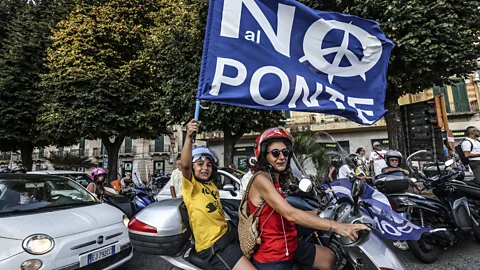 Getty Images
Getty Images
Gioia is more scathing about the project, which she considers both a "dangerous joke" and a "sketchy business", given potential mafia meddling.
A spokesperson for Trenitalia tells me it is too soon to say whether the train-ferry service will stay if the bridge is built, but the operator understands people's affection for it. "In the past, many saw this moment as lost time and an unavoidable pause that prolonged the journey," says Serra. "But, in recent years, we have chosen to provide a narrative for what it truly is: a genuine travel experience and an integral part of the journey."
For now, "the lyrical beauty of this crossing", as Serra described it, is still there to be enjoyed; a small miracle of engineering and nostalgia, rising and falling with the waves.
--
If you liked this story, sign up for The Essential List newsletter – a handpicked selection of features, videos and can't-miss news, delivered to your inbox twice a week.
For more Travel stories from the BBC, follow us on Facebook and Instagram.
.png)

